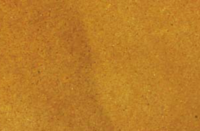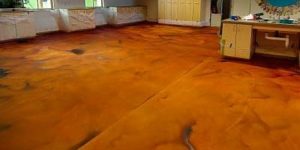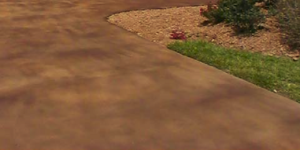Question: The last two times I have acid stained existing, untreated, basement concrete floors, I’ve unintentionally created footprints in the acid stain finish. I didn’t create them by walking across the wet stain, as I always use spiked sandals when I apply stain. I think they were formed during the cleaning process when prior to staining I scrubbed the floor with my rotary floor machine.

Here’s what I think: The soap was so concentrated that when I walked on the sudsy water-detergent mixture during cleaning, my feet pressed the detergent into the floor and left behind an impression of the soles of my shoes. Then, in the areas of that pattern, the detergent resisted or lessened the chemical reaction from the acid stain, resulting in not a complete lack of color, just a much lighter color.
I also have encountered a similar shadowing on concrete while using other surface prep-related products, like methylene chloride and sealer strippers, but I could see those footprints when the slab was wet. This other footprint problem is different in that there is no visible shadowing left behind, even when the slab is wet. The footprints only appear after the acid staining.
On the first project where this happened, I noticed it right away and began scrubbing in the stain to get the prints to go away. I kept scrubbing until the stain was completely worked in, or had evaporated, so as not to leave brush marks. In the process, most of the prints went away.
On the most recent project, the prints appeared immediately in the wet stain. I scrubbed as soon as I noticed them but they held fast. So I applied a second coat of stain. That helped disguise them, but they did not completely go away even after the stain had dried.
I think the soap ingredients have changed. I plan to ask the soap manufacturer if it has changed the formula of a product I have used for years without issue. Having been in the staining business for 15 years, I know how temperamental the acid staining process can be so I’m very careful about what I use during cleaning. I just never foresaw having a problem with a detergent, especially an ecofriendly one. I’ve done a little research, and many other successful staining contractors use TSP or a TSP substitute to clean the concrete before staining. I plan to try TSP next.

In your opinion, what do you think is occurring?
It is not too often I get a question that also contains the answer. You got most of it right.
Having seen this issue before, and after speaking with other experts and installers, my belief is that walking on the slab when there were high concentrations of soap drove the soap into the floor, leaving a heavier concentration in those places. Depending on the soap and the concrete’s porosity, footprints diluted the stain and lessened the chemical reaction, which resulted in reduced color. I have seen this phenomenon range from very faint shadowing to complete stain blockage.
I think you have it figured out, with the exception of the soap manufacturer changing its formula. Having worked for chemical manufacturers for close to 20 years, I know that changing the formula of a nationally sold brand-name product is not something taken lightly or done easily. When a formula is changed, it is a major undertaking at considerable expense. The marketing department usually gets involved to create a “New and Improved Formula” campaign to get more bang for the buck out of the change.
So if the product or your process did not change, what did? What changes on every stain project? The concrete and environmental conditions!
Many times I have seen where the finish and/or the concrete’s porosity, along with environmental conditions, create major differences in the entire stain process with each project. After 15 years in the staining business, you know how temperamental acid staining can be and part of this issue is just that. Concrete differs from project to project. Even the best planning, processes and quality assurance procedures can’t always prevent issues from occurring.
Now let’s look at why this occurred. Not seeing footprints when the slab was cleaned with water indicates that the contaminants creating the footprints were water soluble. In other cases where solvents, oils or non-water-soluble contaminants are present, they repel water, and the footprints show up clearly when the slab is wet from cleaning.
If you get any color when staining concrete, the stain is working — it’s just a case of how well it’s working. In these cases, the higher concentrations of soap from the footprints are diluting and/or blocking the stain, reducing the stain color in those areas.
For all these reasons, I have repeatedly said: “When staining, treat the floor like a clean room from preparation through sealing.” Shoe protectors or spiked shoes are a great idea, even when cleaning. You never know what you bring in on your shoes, or the condition of the concrete in regard to porosity and how it will pick up footprints and other items (pails, cans, bottles, rags, tools, etc.) placed on the concrete. Adding a rinsing step along with vacuuming also will help eliminate soap residue.
Lastly, be open to changing or adjusting your process as needed. If you think the soap is too concentrated, dilute it further or try another type. Personally, I have seen best results using a mineral acid modified with a detergent. These modified acid cleaners, as they are called, are usually diluted a minimum of 40 parts water to one part cleaner, and provide a deep-clean, micro-etched surface. You don’t need to rinse before acid staining — acid stain is soluble in the acid cleaner!
In regard to using trisodium phosphate (TSP), a common soap, it tends to leave a white residue and the wash water can have a negative impact on the environment. For these reasons I like less aggressive or greatly diluted cleaners.















